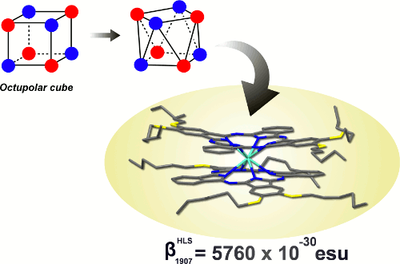Dr. Y. BRETONNIERE
| Quand ? |
12/03/2015 à 13:30 |
|---|---|
| Où ? |
Grande Salle CBP LR6 |
ABAB Homoleptic Bis(phthalocyaninato)lanthanide(III) Complex: Towards the Real Octupolar Cube and Giant Quadratic Nonlinear Efficiency
Design of two-photon absorbing probes for the in-vivo monitoring of oxygen pressure
Octupolar molecules, in which symmetry constraints impose a cancellation of the dipole moment, have considerably extended the possibilities of molecular engineering of second order nonlinear optical molecules by enlarging the dimensionality of the charge transfer. At a structural level, it was shown that the generic template for octupolar molecules is a cube with alternating charges at the edges with an overall tetrahedral symmetry (Td). To match the structure of this cube, we have designed bis(phthalocyaninato)lanthanide (III) sandwich complexes with an unsymmetrical ABAB phthalocyanine bearing alternating electron donor (thioalkoxy) groups and hydrogen atoms acting as weak electron acceptor groups. We will present here the synthesis, structural studies and the investigation of the first molecular hyperpolarizability beta of these very particular objects, as well as studies on the one-electron oxidized and reduced states.

We will then present our ongoing work on two-photon probes for the monitoring of oxygen pressure using the oxygen sensitive phosphorescence of Palladium porphyrin complexes and suitable two-photon absorbing (TPA) antennae. To date four new fluorene-based two-photon absorbing chromophores have been investigated and one of them successfully covalently attached to a central phosphorescent core via Cu(I) catalyzed click reaction. The new compounds contain four or eight TPA antennae connected to a Pd porphyrin acceptor via 1,2,3-triazole linkage. The fluorescence of the antenna is significantly quenched and a good energy transfer to the central core was shown. Those compounds demonstrate that the incorporation of a suitable donor can enhance the effective TPA cross-section of the system allowing efficient oxygen monitoring following an excitation at 800 nm.



